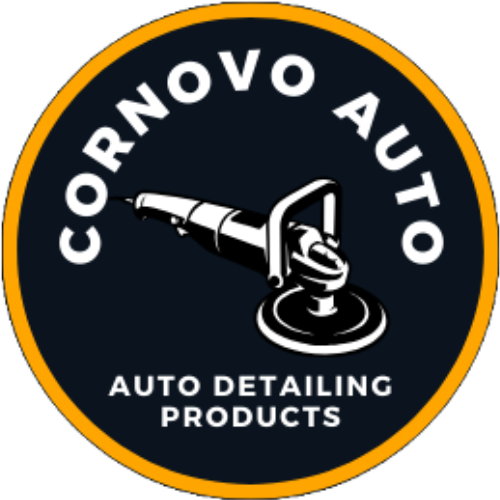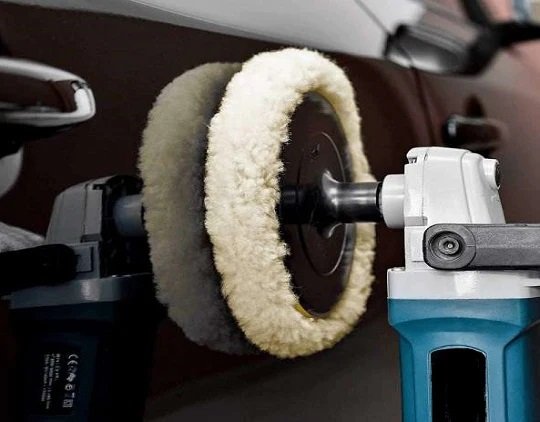A wool buffing pad is a circular pad made from natural or synthetic fibers. The fibers are woven or knitted together to create a dense and durable surface that can be used to apply and remove compounds and polishes on a vehicle’s paintwork. Wool pads are typically attached to a rotary or dual-action polisher, and they come in various sizes and densities. They can be used to remove defects, such as swirls, scratches, and oxidation, and to restore the shine and clarity of the paint.
Types of Wool Buffing Pads
Wool buffing pads come in different types and densities. The two main types of wool pads are natural and synthetic.
Natural Wool Pads
Natural wool pads are made from sheep’s wool. They are typically denser and thicker than synthetic wool pads, which makes them more aggressive and efficient at cutting defects. Natural wool pads are ideal for heavy defect removal and leveling the paint. They are available in different grades, ranging from coarse to fine, depending on the level of defect removal required. Coarse wool pads are used for heavy defect removal, while finer wool pads are used for polishing and finishing.
Synthetic Wool Pads
Synthetic wool pads are made from polyester or other synthetic fibers. They are typically less dense and thinner than natural wool pads, which makes them less aggressive but more versatile. Synthetic wool pads are ideal for lighter defect removal and finishing work. They are available in different grades, ranging from coarse to fine, depending on the level of defect removal required. Coarse synthetic wool pads are used for heavy defect removal, while finer synthetic wool pads are used for polishing and finishing.
Wool Pad Densities
Wool buffing pads come in different densities, which affect their cutting ability and durability. The three main densities of wool pads are:
Soft: Soft wool pads are the least aggressive and are typically used for finishing work. They have a lower cut rate and produce less heat, which makes them less likely to burn the paint. Soft wool pads are ideal for use with fine polishes and waxes.
Medium: Medium wool pads are more aggressive than soft pads but less aggressive than hard pads. They have a higher cut rate and produce more heat, which makes them more effective at removing defects. Medium wool pads are ideal for use with medium polishes and compounds.
Hard: Hard wool pads are the most aggressive and are typically used for heavy defect removal. They have a high cut rate and produce a lot of heat, which makes them more likely to burn the paint. Hard wool pads are ideal for use with heavy compounds.
Wool Pad Shapes and Sizes
Wool buffing pads come in different shapes and sizes to fit different polishing machines and applications. The most common shapes of wool pads are:
Flat: Flat wool pads are the most common shape of wool pads. They are circular and have a flat surface that makes them ideal for use on flat surfaces.
Wavy: Wavy wool pads have a wavy surface that makes them more effective at cutting defects on curved surfaces.
Convex: Convex wool pads have a curved surface that makes them more effective at cutting defects on concave surfaces. Wool pads also come in different sizes, ranging from 3 inches to 12 inches in diameter.
wool buffing pads usage :
Wool buffing pads are used to apply and remove compounds and polishes on a vehicle’s paintwork. They are typically attached to a rotary or dual-action polisher and used in a multi-step polishing process to remove defects and restore the shine and clarity of the paint. Here are the main steps in using wool buffing pads:
Step 1: Preparation
Before using a wool buffing pad, it’s important to prepare the surface to be polished. This involves washing the vehicle to remove any dirt or debris that could scratch the paint, and using a clay bar to remove any embedded contaminants. Once the surface is clean and smooth, you can proceed to the next step.
Step 2: Compound Application
The first step in using a wool buffing pad is to apply a compound to the pad. The compound is a abrasive material that is designed to remove defects such as swirls, scratches, and oxidation from the paint. To apply the compound, place a small amount on the pad and spread it evenly across the surface.
Step 3: Buffing
Next, attach the wool buffing pad to the polisher and turn it on. Start with a low speed and gradually increase the speed to the recommended level for the type of wool pad being used. Apply the pad to the surface with light to moderate pressure, moving the polisher in a back-and-forth or circular motion. Work in small sections at a time, and be careful not to overwork the area, as this can create excessive heat and burn the paint.
Step 4: Polishing
After buffing the surface with the wool pad and compound, switch to a foam pad and apply a polishing compound to the pad. This step is designed to remove any remaining defects and refine the finish to a high gloss shine. Follow the same buffing technique as in step 3, using light to moderate pressure and working in small sections at a time.
Step 5: Finishing
The final step in using wool buffing pads is to apply a finishing wax or sealant to protect the paint and enhance the shine. Apply a small amount of the product to a foam pad and work it into the surface in the same way as in steps 3 and 4.
Allow the product to dry to a haze and then buff it off with a clean microfiber towel.
Tips for Using Wool Buffing Pads
Use the right type and density of wool pad for the job. Coarse wool pads are designed for heavy defect removal, while finer wool pads are designed for polishing and finishing.
Use the right speed and pressure. Start with a low speed and gradually increase it to the recommended level for the type of wool pad being used. Apply light to moderate pressure, and avoid overworking the surface.
Use a clean pad. Before using a wool pad, make sure it is clean and free from debris that could scratch the paint. If the pad becomes caked with compound or polish, clean it with a pad cleaner to restore its cutting ability.
Keep the pad cool. Wool pads generate a lot of heat when in use, which can burn the paint if not kept cool. To prevent this, periodically mist the pad with water or use a pad cooler to keep it cool.
Work in small sections. Buffing the entire surface at once can be overwhelming and increase the risk of overworking the surface. Work in small sections at a time, and be thorough in your work.
Follow manufacturer’s instructions. Always read the instructions and recommendations of the manufacturer of the pad, compound, and polisher being used. This will ensure that you get the best results and avoid any damage to the paint.
What pad is best for buffing?
The best pad for buffing depends on the type of paintwork you are working on, the level of defects you are trying to remove, and the type of polisher you are using. Generally, foam pads and wool pads are the two main types of pads used for buffing.
Foam pads are generally used for polishing and finishing, while wool pads are used for more aggressive defect removal. Foam pads come in various colors and levels of firmness, and they can be used with either a rotary or dual-action polisher. They are a good choice for removing light defects such as swirl marks and fine scratches, and they are less aggressive than wool pads. Foam pads are also less likely to generate heat, which can be a concern when working with delicate paint finishes.
Wool pads are generally used for more aggressive defect removal, such as heavy swirl marks and scratches, and they are typically used with a rotary polisher. Wool pads are available in various levels of coarseness and density, and they can remove defects quickly and efficiently. However, they are more likely to generate heat and can be more aggressive on the paint if used incorrectly.
In general, if you are working on a vehicle with delicate or soft paintwork, foam pads are a better choice for buffing. If you are working on a vehicle with harder paint or more severe defects, wool pads may be a better choice. It’s important to choose the right pad for the job and to follow the manufacturer’s instructions for the pad, compound, and polisher being used.
Conclusion :
Wool buffing pads are an essential tool in the process of restoring the shine and clarity of a vehicle’s paintwork. They are an excellent choice for removing heavy defects such as swirl marks and scratches, and they are available in various levels of coarseness and density to suit different types of paint and defect levels.
When using wool buffing pads, it’s important to follow the manufacturer’s instructions and to use the right type and density of pad for the job. It’s also important to keep the pad clean and cool, to work in small sections, and to use light to moderate pressure to avoid overworking the surface.
While wool pads are an effective tool for removing defects, they are not the only tool in the polishing process. Foam pads are typically used for polishing and finishing, and they can provide a smoother, more refined finish than wool pads. The choice of pad will depend on the type of paintwork, the level of defects, and the desired level of finish.
In conclusion, wool buffing pads are an essential tool for anyone who wants to restore the shine and clarity of a vehicle’s paintwork. They can remove heavy defects quickly and efficiently, and they are available in various levels of coarseness and density to suit different types of paint and defect levels. With the right technique and care, wool buffing pads can help to achieve a smooth, glossy finish that will make any vehicle look like new.


